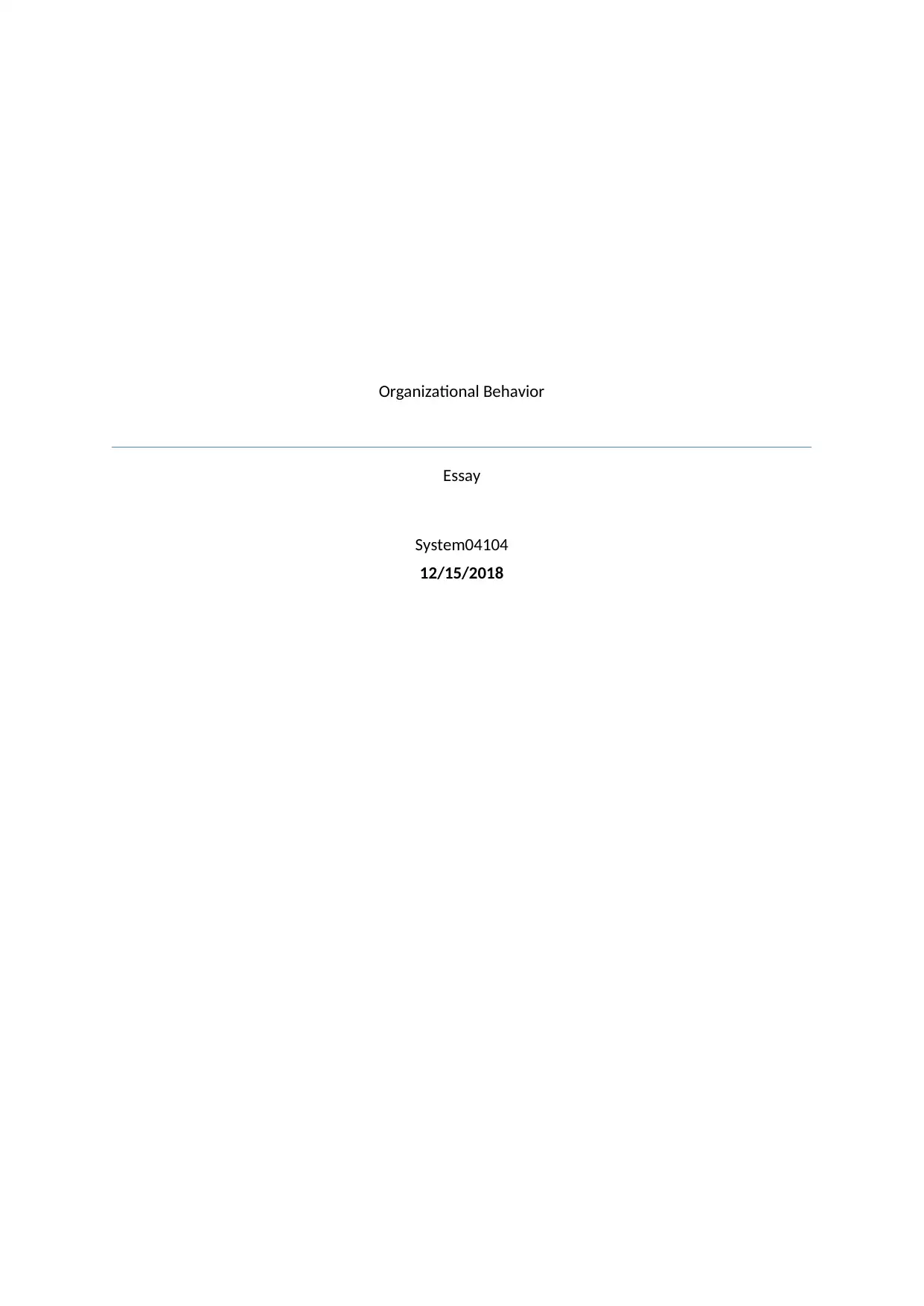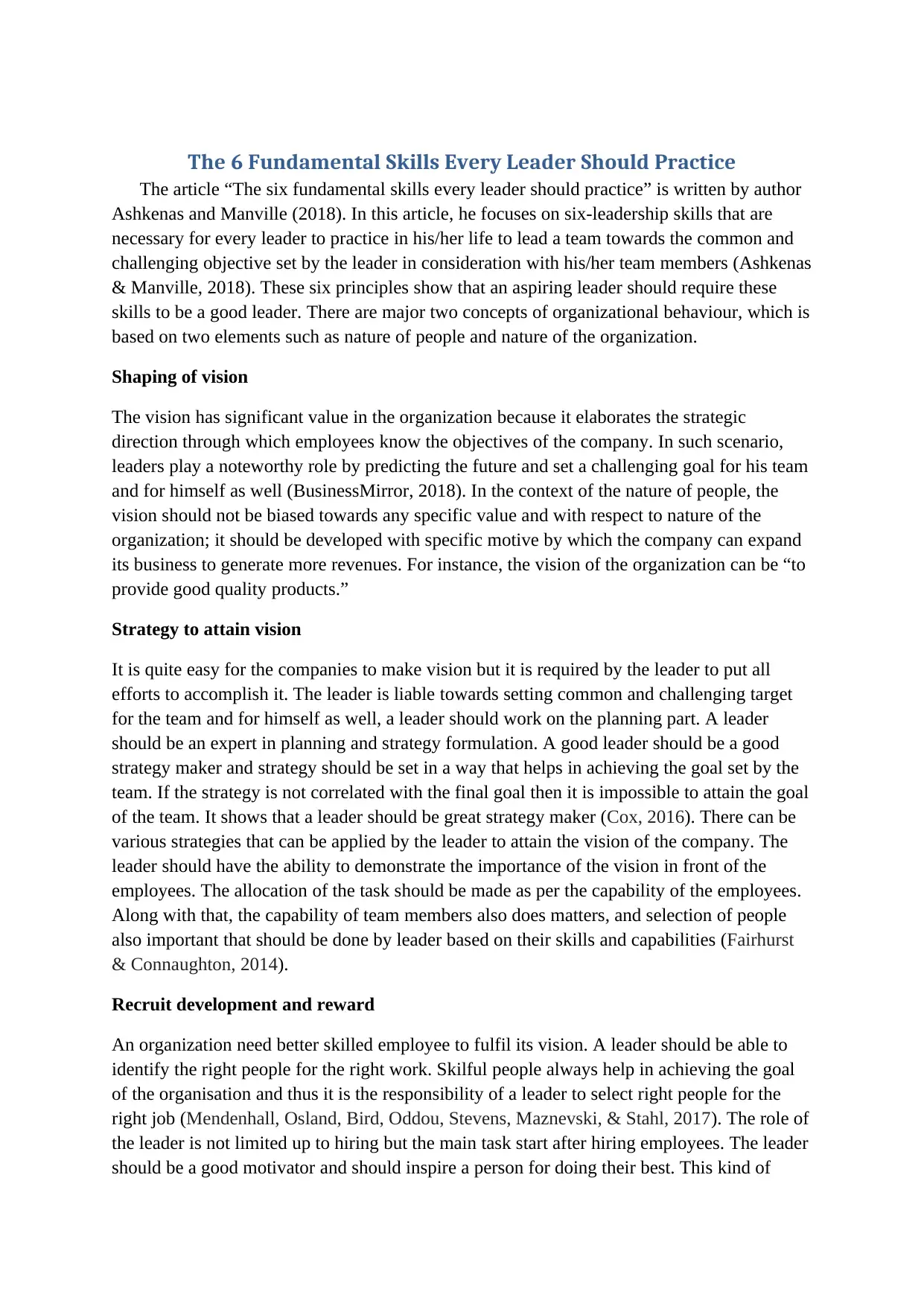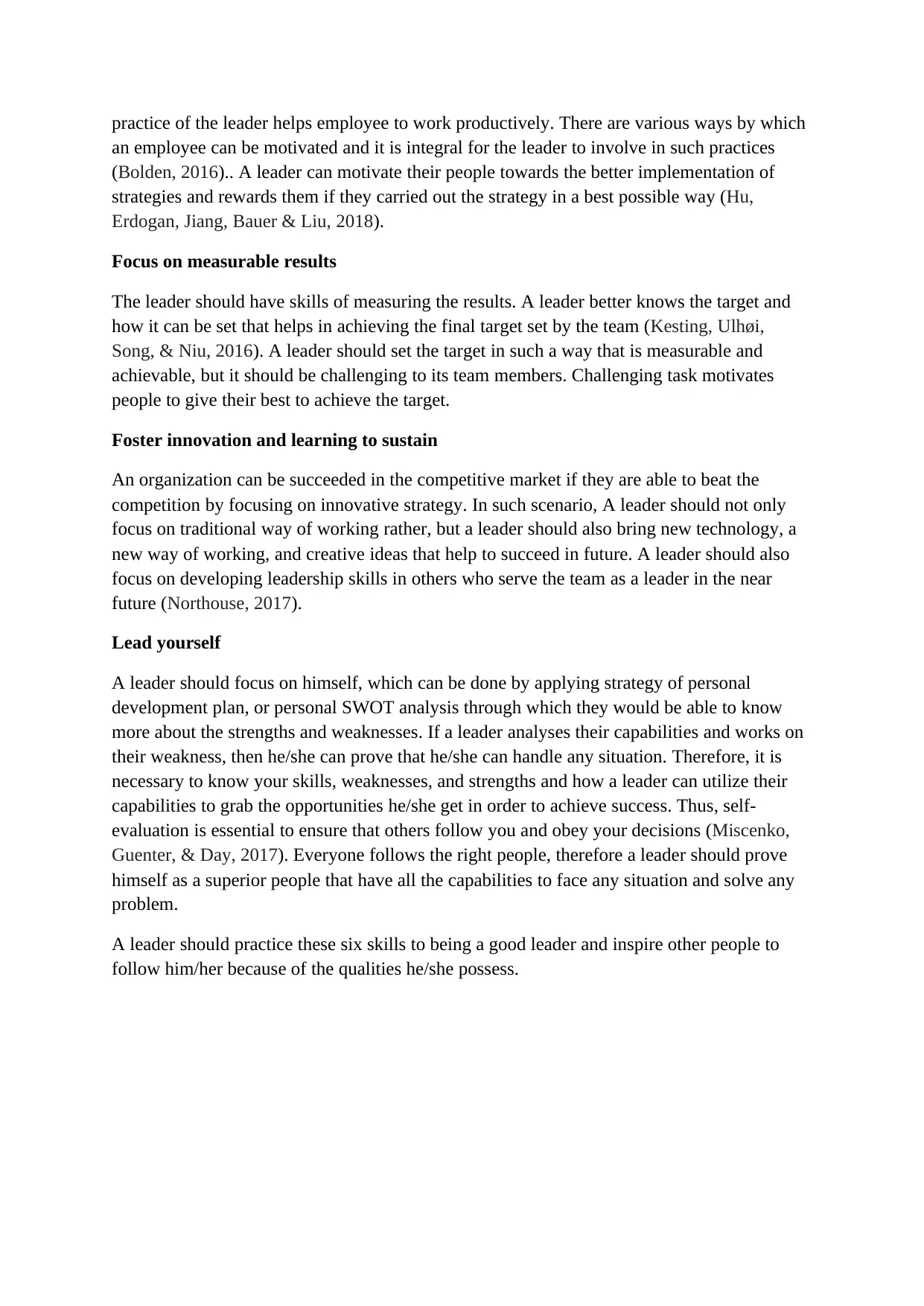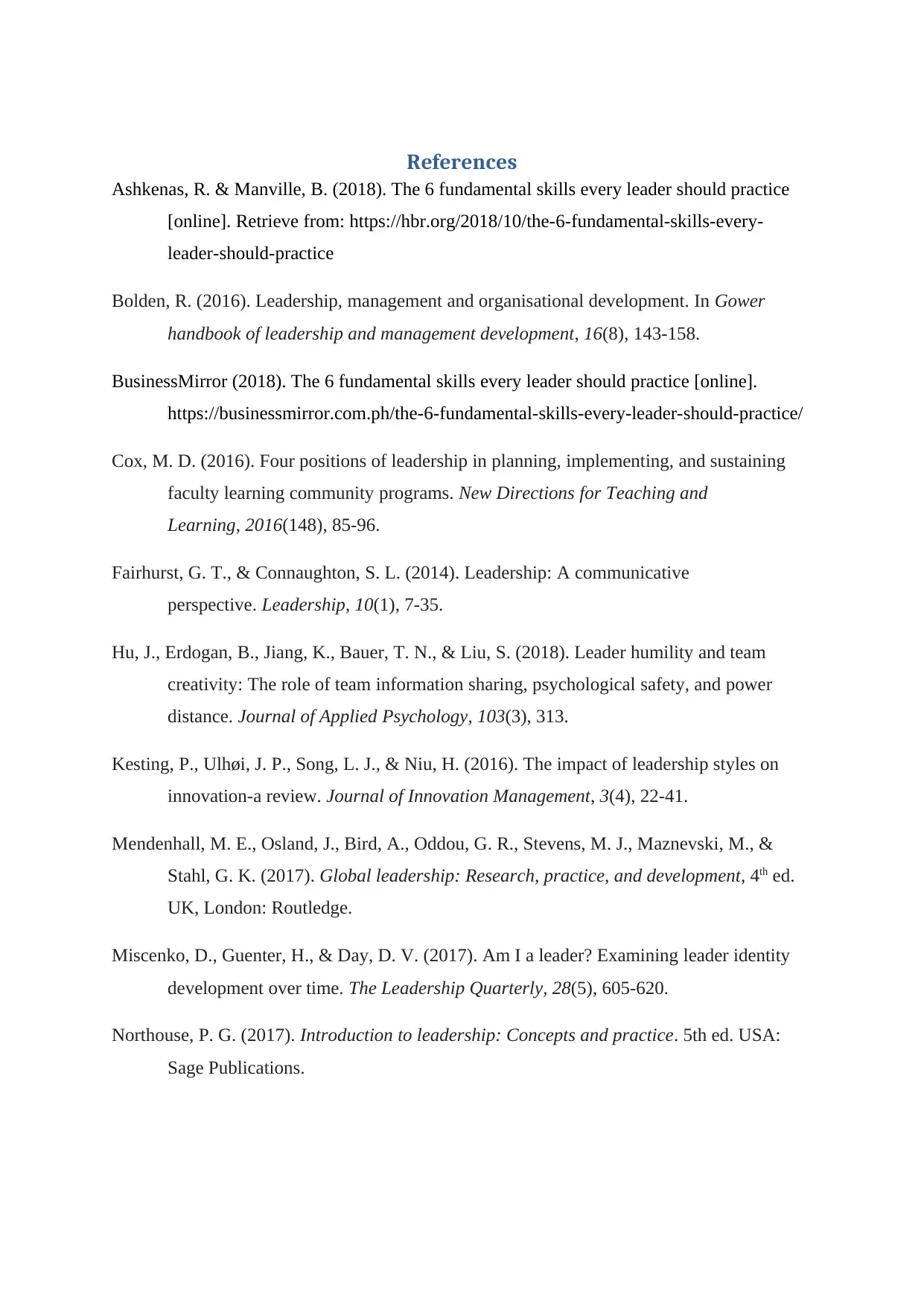Organizational Behavior Essay: The Six Fundamental Leadership Skills
VerifiedAdded on 2023/05/26
|4
|1411
|307
Essay
AI Summary
This essay analyzes the six fundamental leadership skills every leader should practice, as highlighted in the article by Ashkenas and Manville (2018). The essay delves into the core concepts of organizational behavior, focusing on the nature of people and organizations. It emphasizes the importance of shaping a clear vision, developing effective strategies to achieve that vision, recruiting and developing skilled employees, focusing on measurable results, fostering innovation and learning, and leading oneself. Each skill is explored with examples, such as setting challenging goals, allocating tasks based on employee capabilities, and motivating employees through rewards. The essay underscores the significance of self-evaluation for leaders to inspire others and handle various situations effectively. The essay concludes by reiterating the importance of these six skills in becoming a successful leader.

Organizational Behavior
Essay
System04104
12/15/2018
Essay
System04104
12/15/2018
Paraphrase This Document
Need a fresh take? Get an instant paraphrase of this document with our AI Paraphraser

The 6 Fundamental Skills Every Leader Should Practice
The article “The six fundamental skills every leader should practice” is written by author
Ashkenas and Manville (2018). In this article, he focuses on six-leadership skills that are
necessary for every leader to practice in his/her life to lead a team towards the common and
challenging objective set by the leader in consideration with his/her team members (Ashkenas
& Manville, 2018). These six principles show that an aspiring leader should require these
skills to be a good leader. There are major two concepts of organizational behaviour, which is
based on two elements such as nature of people and nature of the organization.
Shaping of vision
The vision has significant value in the organization because it elaborates the strategic
direction through which employees know the objectives of the company. In such scenario,
leaders play a noteworthy role by predicting the future and set a challenging goal for his team
and for himself as well (BusinessMirror, 2018). In the context of the nature of people, the
vision should not be biased towards any specific value and with respect to nature of the
organization; it should be developed with specific motive by which the company can expand
its business to generate more revenues. For instance, the vision of the organization can be “to
provide good quality products.”
Strategy to attain vision
It is quite easy for the companies to make vision but it is required by the leader to put all
efforts to accomplish it. The leader is liable towards setting common and challenging target
for the team and for himself as well, a leader should work on the planning part. A leader
should be an expert in planning and strategy formulation. A good leader should be a good
strategy maker and strategy should be set in a way that helps in achieving the goal set by the
team. If the strategy is not correlated with the final goal then it is impossible to attain the goal
of the team. It shows that a leader should be great strategy maker (Cox, 2016). There can be
various strategies that can be applied by the leader to attain the vision of the company. The
leader should have the ability to demonstrate the importance of the vision in front of the
employees. The allocation of the task should be made as per the capability of the employees.
Along with that, the capability of team members also does matters, and selection of people
also important that should be done by leader based on their skills and capabilities (Fairhurst
& Connaughton, 2014).
Recruit development and reward
An organization need better skilled employee to fulfil its vision. A leader should be able to
identify the right people for the right work. Skilful people always help in achieving the goal
of the organisation and thus it is the responsibility of a leader to select right people for the
right job (Mendenhall, Osland, Bird, Oddou, Stevens, Maznevski, & Stahl, 2017). The role of
the leader is not limited up to hiring but the main task start after hiring employees. The leader
should be a good motivator and should inspire a person for doing their best. This kind of
The article “The six fundamental skills every leader should practice” is written by author
Ashkenas and Manville (2018). In this article, he focuses on six-leadership skills that are
necessary for every leader to practice in his/her life to lead a team towards the common and
challenging objective set by the leader in consideration with his/her team members (Ashkenas
& Manville, 2018). These six principles show that an aspiring leader should require these
skills to be a good leader. There are major two concepts of organizational behaviour, which is
based on two elements such as nature of people and nature of the organization.
Shaping of vision
The vision has significant value in the organization because it elaborates the strategic
direction through which employees know the objectives of the company. In such scenario,
leaders play a noteworthy role by predicting the future and set a challenging goal for his team
and for himself as well (BusinessMirror, 2018). In the context of the nature of people, the
vision should not be biased towards any specific value and with respect to nature of the
organization; it should be developed with specific motive by which the company can expand
its business to generate more revenues. For instance, the vision of the organization can be “to
provide good quality products.”
Strategy to attain vision
It is quite easy for the companies to make vision but it is required by the leader to put all
efforts to accomplish it. The leader is liable towards setting common and challenging target
for the team and for himself as well, a leader should work on the planning part. A leader
should be an expert in planning and strategy formulation. A good leader should be a good
strategy maker and strategy should be set in a way that helps in achieving the goal set by the
team. If the strategy is not correlated with the final goal then it is impossible to attain the goal
of the team. It shows that a leader should be great strategy maker (Cox, 2016). There can be
various strategies that can be applied by the leader to attain the vision of the company. The
leader should have the ability to demonstrate the importance of the vision in front of the
employees. The allocation of the task should be made as per the capability of the employees.
Along with that, the capability of team members also does matters, and selection of people
also important that should be done by leader based on their skills and capabilities (Fairhurst
& Connaughton, 2014).
Recruit development and reward
An organization need better skilled employee to fulfil its vision. A leader should be able to
identify the right people for the right work. Skilful people always help in achieving the goal
of the organisation and thus it is the responsibility of a leader to select right people for the
right job (Mendenhall, Osland, Bird, Oddou, Stevens, Maznevski, & Stahl, 2017). The role of
the leader is not limited up to hiring but the main task start after hiring employees. The leader
should be a good motivator and should inspire a person for doing their best. This kind of

practice of the leader helps employee to work productively. There are various ways by which
an employee can be motivated and it is integral for the leader to involve in such practices
(Bolden, 2016).. A leader can motivate their people towards the better implementation of
strategies and rewards them if they carried out the strategy in a best possible way (Hu,
Erdogan, Jiang, Bauer & Liu, 2018).
Focus on measurable results
The leader should have skills of measuring the results. A leader better knows the target and
how it can be set that helps in achieving the final target set by the team (Kesting, Ulhøi,
Song, & Niu, 2016). A leader should set the target in such a way that is measurable and
achievable, but it should be challenging to its team members. Challenging task motivates
people to give their best to achieve the target.
Foster innovation and learning to sustain
An organization can be succeeded in the competitive market if they are able to beat the
competition by focusing on innovative strategy. In such scenario, A leader should not only
focus on traditional way of working rather, but a leader should also bring new technology, a
new way of working, and creative ideas that help to succeed in future. A leader should also
focus on developing leadership skills in others who serve the team as a leader in the near
future (Northouse, 2017).
Lead yourself
A leader should focus on himself, which can be done by applying strategy of personal
development plan, or personal SWOT analysis through which they would be able to know
more about the strengths and weaknesses. If a leader analyses their capabilities and works on
their weakness, then he/she can prove that he/she can handle any situation. Therefore, it is
necessary to know your skills, weaknesses, and strengths and how a leader can utilize their
capabilities to grab the opportunities he/she get in order to achieve success. Thus, self-
evaluation is essential to ensure that others follow you and obey your decisions (Miscenko,
Guenter, & Day, 2017). Everyone follows the right people, therefore a leader should prove
himself as a superior people that have all the capabilities to face any situation and solve any
problem.
A leader should practice these six skills to being a good leader and inspire other people to
follow him/her because of the qualities he/she possess.
an employee can be motivated and it is integral for the leader to involve in such practices
(Bolden, 2016).. A leader can motivate their people towards the better implementation of
strategies and rewards them if they carried out the strategy in a best possible way (Hu,
Erdogan, Jiang, Bauer & Liu, 2018).
Focus on measurable results
The leader should have skills of measuring the results. A leader better knows the target and
how it can be set that helps in achieving the final target set by the team (Kesting, Ulhøi,
Song, & Niu, 2016). A leader should set the target in such a way that is measurable and
achievable, but it should be challenging to its team members. Challenging task motivates
people to give their best to achieve the target.
Foster innovation and learning to sustain
An organization can be succeeded in the competitive market if they are able to beat the
competition by focusing on innovative strategy. In such scenario, A leader should not only
focus on traditional way of working rather, but a leader should also bring new technology, a
new way of working, and creative ideas that help to succeed in future. A leader should also
focus on developing leadership skills in others who serve the team as a leader in the near
future (Northouse, 2017).
Lead yourself
A leader should focus on himself, which can be done by applying strategy of personal
development plan, or personal SWOT analysis through which they would be able to know
more about the strengths and weaknesses. If a leader analyses their capabilities and works on
their weakness, then he/she can prove that he/she can handle any situation. Therefore, it is
necessary to know your skills, weaknesses, and strengths and how a leader can utilize their
capabilities to grab the opportunities he/she get in order to achieve success. Thus, self-
evaluation is essential to ensure that others follow you and obey your decisions (Miscenko,
Guenter, & Day, 2017). Everyone follows the right people, therefore a leader should prove
himself as a superior people that have all the capabilities to face any situation and solve any
problem.
A leader should practice these six skills to being a good leader and inspire other people to
follow him/her because of the qualities he/she possess.
⊘ This is a preview!⊘
Do you want full access?
Subscribe today to unlock all pages.

Trusted by 1+ million students worldwide

References
Ashkenas, R. & Manville, B. (2018). The 6 fundamental skills every leader should practice
[online]. Retrieve from: https://hbr.org/2018/10/the-6-fundamental-skills-every-
leader-should-practice
Bolden, R. (2016). Leadership, management and organisational development. In Gower
handbook of leadership and management development, 16(8), 143-158.
BusinessMirror (2018). The 6 fundamental skills every leader should practice [online].
https://businessmirror.com.ph/the-6-fundamental-skills-every-leader-should-practice/
Cox, M. D. (2016). Four positions of leadership in planning, implementing, and sustaining
faculty learning community programs. New Directions for Teaching and
Learning, 2016(148), 85-96.
Fairhurst, G. T., & Connaughton, S. L. (2014). Leadership: A communicative
perspective. Leadership, 10(1), 7-35.
Hu, J., Erdogan, B., Jiang, K., Bauer, T. N., & Liu, S. (2018). Leader humility and team
creativity: The role of team information sharing, psychological safety, and power
distance. Journal of Applied Psychology, 103(3), 313.
Kesting, P., Ulhøi, J. P., Song, L. J., & Niu, H. (2016). The impact of leadership styles on
innovation-a review. Journal of Innovation Management, 3(4), 22-41.
Mendenhall, M. E., Osland, J., Bird, A., Oddou, G. R., Stevens, M. J., Maznevski, M., &
Stahl, G. K. (2017). Global leadership: Research, practice, and development, 4th ed.
UK, London: Routledge.
Miscenko, D., Guenter, H., & Day, D. V. (2017). Am I a leader? Examining leader identity
development over time. The Leadership Quarterly, 28(5), 605-620.
Northouse, P. G. (2017). Introduction to leadership: Concepts and practice. 5th ed. USA:
Sage Publications.
Ashkenas, R. & Manville, B. (2018). The 6 fundamental skills every leader should practice
[online]. Retrieve from: https://hbr.org/2018/10/the-6-fundamental-skills-every-
leader-should-practice
Bolden, R. (2016). Leadership, management and organisational development. In Gower
handbook of leadership and management development, 16(8), 143-158.
BusinessMirror (2018). The 6 fundamental skills every leader should practice [online].
https://businessmirror.com.ph/the-6-fundamental-skills-every-leader-should-practice/
Cox, M. D. (2016). Four positions of leadership in planning, implementing, and sustaining
faculty learning community programs. New Directions for Teaching and
Learning, 2016(148), 85-96.
Fairhurst, G. T., & Connaughton, S. L. (2014). Leadership: A communicative
perspective. Leadership, 10(1), 7-35.
Hu, J., Erdogan, B., Jiang, K., Bauer, T. N., & Liu, S. (2018). Leader humility and team
creativity: The role of team information sharing, psychological safety, and power
distance. Journal of Applied Psychology, 103(3), 313.
Kesting, P., Ulhøi, J. P., Song, L. J., & Niu, H. (2016). The impact of leadership styles on
innovation-a review. Journal of Innovation Management, 3(4), 22-41.
Mendenhall, M. E., Osland, J., Bird, A., Oddou, G. R., Stevens, M. J., Maznevski, M., &
Stahl, G. K. (2017). Global leadership: Research, practice, and development, 4th ed.
UK, London: Routledge.
Miscenko, D., Guenter, H., & Day, D. V. (2017). Am I a leader? Examining leader identity
development over time. The Leadership Quarterly, 28(5), 605-620.
Northouse, P. G. (2017). Introduction to leadership: Concepts and practice. 5th ed. USA:
Sage Publications.
1 out of 4
Related Documents
Your All-in-One AI-Powered Toolkit for Academic Success.
+13062052269
info@desklib.com
Available 24*7 on WhatsApp / Email
![[object Object]](/_next/static/media/star-bottom.7253800d.svg)
Unlock your academic potential
Copyright © 2020–2025 A2Z Services. All Rights Reserved. Developed and managed by ZUCOL.





